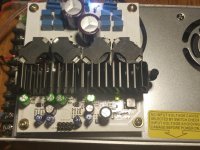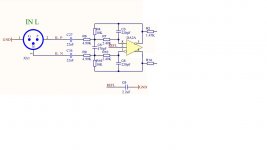I agree its confusing - nobody to my knowledge uses analog input classD without feedback, so that final sentence is crucial. Digital input classD is often found without feedback though - TI has some chipsets with feedback (they term this 'closed loop') and some without ('open loop').
You're not wrong about your confusion!
Think about the PWM-based proportional-to-bus-voltage-gain as part the internal loop gain of the amplifier, but then there's a pre-filter feedback network which sets the overall gain of the block. Since the error amp will dominate the internal loop gain, the small change in the class-D amp's gain with bus voltage will not materially affect the gain set by the feedback network.
From the outside as users of the chipamp, we are "stuck" with the already-established internal feedback network, so the gain is pinned to 21.5 dB
Think about the PWM-based proportional-to-bus-voltage-gain as part the internal loop gain of the amplifier, but then there's a pre-filter feedback network which sets the overall gain of the block. Since the error amp will dominate the internal loop gain, the small change in the class-D amp's gain with bus voltage will not materially affect the gain set by the feedback network.
From the outside as users of the chipamp, we are "stuck" with the already-established internal feedback network, so the gain is pinned to 21.5 dB
You're not wrong about your confusion!
From the outside as users of the chipamp, we are "stuck" with the already-established internal feedback network, so the gain is pinned to 21.5 dB
Thanks guys! I've been studying passive circuits, but with the purchase of this EVM I've started studying active circuits. Feedback is slowly sinking in!
Just to satisfy my own curiosity, I created a 400Hz signal at .64 volts and measured the speaker out voltage. It was 15.27 volts, which equates to a 27.5 dB gain. Since I'm running this amp BTL, the output voltage would double vs se, which would account for the extra 6 dB.
Mike
Input opamps full defferential THS4131, PSU MW LRS-350-48.
Nice, what Vref are you using THS413X?
To take full advantage of the specs of this fully differential amp, source impedance should be quite low. This will work fine with a balanced DAC current output - but with any other real sources?
Works great with a sound card EMU0204USB
What is considered a low output inpeadance? My foreplay was listed around 1300 ohms.
Depends on the resistor values around the differential amp.
For lowest noise figure you will find several 100 Ohms.
Have a look at the data sheet.
I would expect this to work even with >1k source impedance. The drawback is increased noise - but this will be quite low as well. All in all these noise figures of 1nV/sqrt(Hz) are more or less academic as in most real cases your audio source will contribute far more noise.
- Home
- Amplifiers
- Class D
- TPA3255 - all about DIY, Discussion, Design etc

